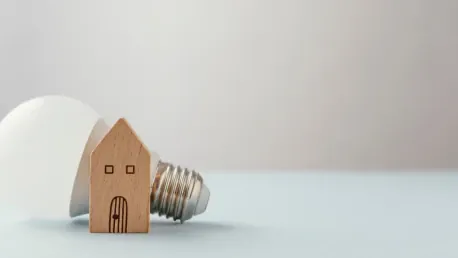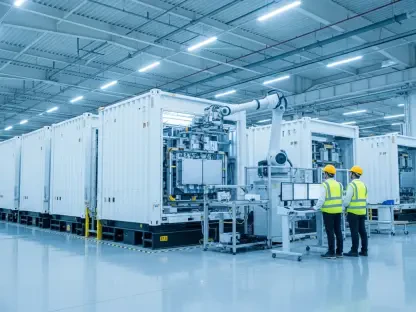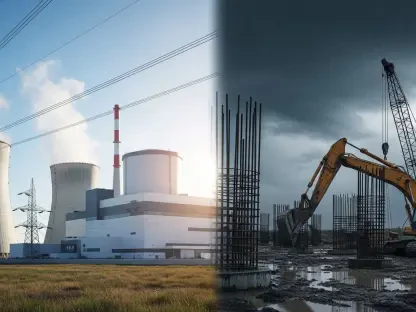The power grid, which serves as the central nervous system of the U.S. energy ecosystem, is responsible for delivering electricity from power plants to residential and commercial areas through an extensive network of transmission and distribution lines. Significant fluctuations in electricity demand throughout the day necessitate reliance on fossil fuel-based power plants during peak hours, particularly in the mornings and evenings. However, this dependency leads to higher emissions and elevated costs. The shift toward energy-efficient homes is increasingly seen as a viable solution to mitigate these issues by reducing electricity consumption through improved insulation, high-efficiency appliances, and smart technologies.
Reducing Electricity Demand
Lowering Peak Demand
Energy-efficient homes play a crucial role in curbing fluctuating electricity demand, thus minimizing the extent to which utilities need to turn to fossil fuel power plants. Homes equipped with high-performance insulation, smart thermostats, and energy-efficient appliances inherently demand less electricity, thus lowering the dependency on non-renewable energy sources. This reduction is instrumental in decreasing overall carbon emissions and mitigating the environmental impact of electricity generation. By curbing the need for constant heating and cooling, maintaining stable indoor temperatures becomes easier and more energy-efficient.
Smart technology further enhances the optimization of energy use in households. Systems like smart thermostats and home automation platforms enable residents to regulate energy consumption in real time, based on actual requirements as opposed to projected needs. This adaptability not only lowers peak electricity demand but also reduces the overall load on the power grid. By distributing power usage more evenly throughout the day, energy-efficient homes prevent sudden spikes in electricity consumption, thereby reducing the risk of blackouts and enhancing the grid’s reliability.
Benefits of Smart Technology
Smart thermostats and home automation systems significantly contribute to reducing energy consumption by making real-time adjustments that align with current needs. These devices are designed to track and learn user behaviors, adjusting heating, cooling, and appliance usage accordingly. For instance, a smart thermostat can lower energy consumption by adjusting the temperature when residents are not at home or during sleeping hours. This constant optimization makes it easier to maintain comfortable indoor environments without expending unnecessary energy.
Another critical benefit of smart technology is the ability to use data analytics for more efficient energy management. Utility companies can use data collected from smart devices to predict energy use patterns better and distribute electricity more effectively. This predictive capability helps in balancing supply and demand, reducing the need for emergency power generation from fossil fuel plants. Additionally, smart home systems can alert homeowners to potential energy inefficiencies, such as malfunctioning appliances or poor insulation, prompting timely interventions that further save energy and reduce costs.
Integration of Renewable Energy Sources
Solar Panels and Wind Energy
Energy-efficient homes are often designed to incorporate renewable energy systems such as solar panels, battery storage, and wind power. With their lower energy needs, these homes can make the most out of renewable sources, often generating more electricity than they consume. Through net metering programs, excess electricity can be sold back to the power grid, which helps in its redistribution and storage. This process not only allows homeowners to offset their energy costs but also contributes to a more resilient and sustainable energy infrastructure.
The integration of renewable energy sources in energy-efficient homes has a far-reaching impact on their carbon footprint. By harnessing natural sources of energy, such homes can drastically reduce their reliance on traditional, fossil fuel-based electricity. Solar panels and wind turbines generate power without emitting greenhouse gases, thereby contributing to a cleaner grid. Additionally, renewable energy systems offer financial benefits by providing breaks on utility bills while contributing to the grid’s overall sustainability.
Battery Storage Systems
Battery storage systems serve as a critical component in maximizing the benefits of renewable energy in energy-efficient homes. These systems capture excess solar or wind energy produced during peak generation times and store it for later use, such as during the night or periods when renewable energy generation is low. This capability reduces the need for backup power from fossil fuel-based plants and enhances the overall reliability and stability of the power grid. The ability to store surplus power also means that energy-efficient homes can be less dependent on traditional power sources, promoting a cleaner and more resilient energy system.
By integrating battery storage systems, households can achieve greater energy independence. During power outages or grid failures, stored renewable energy ensures that essential appliances and systems continue to run, thereby enhancing the home’s resilience. Furthermore, many modern battery systems come with smart management features, allowing homeowners to monitor and control energy usage efficiently. This smart energy management extends the benefits of renewable power integration, ensuring that energy is used optimally and wastage is minimized.
Cost Savings for Homeowners
Utility Bill Reductions
One of the most attractive benefits for homeowners investing in energy-efficient upgrades is the significant savings on utility bills. High-efficiency appliances, coupled with smart technology and better insulation, work in tandem to drastically reduce energy consumption. For instance, ENERGY STAR-certified smart thermostats can lower heating and cooling costs by around 8%, automatically adjusting temperatures based on factors such as occupancy and weather conditions. LED lighting, which consumes less electricity than traditional bulbs, is another simple upgrade that leads to substantial savings.
In addition to lowering utility bills, energy-efficient homes contribute to more consistent and manageable energy costs. As these homes demand less power, they are far less susceptible to fluctuations in energy prices. This financial stability is particularly beneficial for households on tight budgets, providing an economic safeguard against rising utility costs. Moreover, these reductions benefit utility companies by easing the strain on the power grid, leading to more efficient energy distribution and potentially even lower rates for all consumers.
Financial Incentives
Energy-efficient home improvements are often incentivized through local, state, or federal programs that offer tax credits and rebates. These financial incentives make it more feasible for homeowners to invest in upgrades and new technologies. Programs such as the federal Residential Renewable Energy Tax Credit provide substantial deductions against the cost of installing solar energy systems, while various state programs offer rebates for energy-efficient appliances and home insulation upgrades.
Beyond rebates and tax credits, some utility companies provide direct incentives for adopting energy-efficient measures. These can take the form of discounted rates on energy-efficient appliances or rebates on the installation of smart home systems. Additionally, participating in demand-response programs, where utility companies offer incentives for reducing energy use during peak times, can further enhance cost savings. Collectively, these financial benefits make investment in energy-efficient homes an economically sound decision that enhances both personal savings and contributes to broader energy sustainability goals.
Steps to Improve Energy Efficiency
Upgrading HVAC Systems
To enhance energy efficiency, upgrading to a high-efficiency HVAC system is crucial. Modern HVAC systems are designed to maintain comfortable indoor environments while using significantly less electricity compared to older models. These high-efficiency units employ advanced technologies to regulate temperature precisely, ensuring optimal energy use. Replacing an outdated heating and cooling system with an energy-efficient model can not only reduce energy consumption but also improve indoor air quality and comfort levels.
In addition to central HVAC systems, other household upgrades can significantly impact energy efficiency. For instance, installing programmable thermostats allows precise control over heating and cooling schedules, minimizing unnecessary energy usage. Furthermore, properly maintaining HVAC systems ensures they operate at peak efficiency. Regular servicing, such as cleaning filters and checking for leaks, can prevent energy wastage and prolong the lifespan of the equipment. These steps collectively contribute to substantial energy savings and reduced environmental impact.
Reducing Phantom Energy Consumption
Phantom energy consumption, often referred to as “standby power,” is the energy used by electronic devices even when they are turned off but still plugged in. This hidden energy drain can account for a significant portion of household electricity use. To combat this, homeowners can unplug devices when not in use or use smart power strips that automatically cut off power to idle devices. Reducing phantom energy not only cuts down on electricity bills but also helps in reducing overall energy consumption, contributing to a more efficient home.
Ceiling fans are a simple and effective tool in reducing the need for air conditioning during summer and redistributing heat in winter. Running ceiling fans can significantly improve air circulation, reducing the workload on HVAC systems and enabling more efficient temperature control. When used wisely, ceiling fans can enhance comfort levels while ensuring that less energy is used for heating and cooling. These small changes, when combined with other energy-efficient measures, can lead to significant long-term savings and improved home sustainability.
Environmental and Health Benefits
Lower Carbon Footprint
Energy-efficient homes have a profound impact on reducing carbon footprints. By minimizing energy consumption and integrating renewable energy sources, these homes significantly lower greenhouse gas emissions. The move toward energy-efficient living is a vital aspect of broader efforts to develop a sustainable energy infrastructure and combat climate change. As more homes adopt energy-efficient practices and renewable technologies, the collective reduction in carbon emissions can contribute to achieving national and global environmental goals.
Moreover, improved energy efficiency in homes means less reliance on fossil fuel-based power plants, which are a major source of carbon dioxide and other pollutants. By reducing the demand for traditional energy generation, energy-efficient homes play a significant role in lowering the overall environmental impact of electricity production. This shift supports a cleaner, more sustainable power grid and paves the way for future advancements in green technology and renewable energy integration.
Improved Air Quality
The shift towards energy-efficient homes significantly impacts air quality. By minimizing energy consumption and lessening reliance on fossil fuels, these homes reduce emissions that contribute to air pollution. Enhanced indoor air quality is another benefit, as better insulation and efficient HVAC systems reduce the infiltration of outdoor pollutants and maintain cleaner indoor environments. Energy-efficient homes, therefore, not only support a healthier planet but also promote the well-being of their inhabitants. This combined effect of environmental and health benefits underscores the importance of advancing energy-efficiency measures in residential settings.









